In recent months, waves of uncertainty have cascaded through the global economy, causing ripples that are now hitting the business aviation sector. According to a recent survey conducted by Barclays, the eagerness to invest in business jets has plummeted by a staggering 49% since March. This sharp decline reflects a broader trend of faltering consumer confidence, positioning the aviation market at a precarious crossroads. The grim statistics indicate that even affluent consumers—once unfazed by economic fluctuations—are now reconsidering their fiscal commitments. As the survey reveals, the appetite for luxury investments is waning, ushering in an era of caution that could have lasting effects.
Indicators of Decline: A Dismal Survey
The Barclays Business Jet Indicator survey, which sampled 65 professionals from the industry between April 9 and 15, paints an alarming picture of economic sentiment. Only one out of five metrics measured—inventory levels—remained stable, while the composite score nosedived from 52 to 40. This 23% decline is not only the largest since the upheaval brought by the Covid pandemic but also serves as a grim forecast for manufacturers. A composite score in the low 40s reeks of stagnation, suggesting that the volume of new orders is faltering, struggling to keep pace with what is currently being fulfilled. As pointed out by Barclays’ analyst David Strauss, the current landscape suggests a chilling fear among buyers, who are now sidelining purchases as the economic clouds loom overhead.
Fears and Tariffs: A Noose Tightens
Diving deeper into the psyche of the market, it becomes clear that these declining interest levels are closely tied to broader concerns, particularly regarding tariffs. The survey revealed that a staggering 93% of respondents anticipate that tariffs will negatively impact new aircraft demand. This statistic alone exemplifies the atmosphere of dread that surrounds potential economic complications. The fear of tariffs looms large; nearly half of the surveyed individuals reported that client interest had deteriorated because of concerns not just limited to aircraft but extending into their broader business operations. It’s as though the once high-flying ambition of business aviation is strafed by an invisible force, suffocated by regulations and economic apprehension.
Mixed Messages: The Struggle for Used Jets
As speculation swirls around new aircraft, the market for used jets conveys its own narrative of pessimism. The numbers are telling; 67% of participants in the Barclays survey expressed a bleak outlook on used aircraft sales, foreseeing either a minor or substantial downturn in demand. Here lies a paradox—while new jets gather dust on the tarmac, around 27% of respondents believe that the market for used jets could see an uptick. Perhaps this reflects a shift towards pragmatism in fiscal behavior, where buyers opt for the comfort of established assets rather than venturing into the uncertain waters of new acquisitions.
A Silver Lining? Legislative Hope
Yet, in the midst of this economic tempest, there exists a glimmer of hope. Potential legislative changes might breathe fresh life into the business jet market. The Senate and House have both shown willingness to extend the Tax Cuts and Jobs Act, drawing attention to the tax incentives that could encourage new purchases. The act allows businesses to immediately deduct 100% of eligible equipment, which could play a pivotal role in stimulating demand if reinstated. Republicans are already eyeing avenues to revert the rate back to this favorable 100% deduction, enhancing the attractiveness of investing in new jets during uncertain economic times.
Nonetheless, it’s vital to maintain a critical eye on these legislative changes. The proposed tax provisions signal a potential lifeline; however, they also risk inundating our economy with temporary fixes rather than substantive resolutions. Without addressing the underlying market fears, one must question whether these measures can truly reverse the prevailing sentiments in the business aircraft market or simply offer a transient reprieve from a foreboding economic reality.
The urgency of the situation cannot be overstated. The sense that the business jet industry is on a precipice is palpable, and as sentiments recess into skepticism, those within the industry must brace for turbulence if they are to navigate these tumultuous skies.

